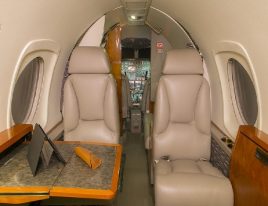Falcon 10 - Description
The Dassault Family creates jets with high standards of engineering, structural quality, and technological advancement. Although Dassault’s models have evolved and improved over time, the Falcon 10, a light, twin-turbo fan business jet, remains popular in the used aircraft market, and for good reasons. It was introduced for the first time in December 1970 to fill the gap between the Falcon 20 and smaller turboprop cabin-class business jets.
In 1983, Dassault redesigned and fine-tuned elements of the Falcon 10, which was renamed the Falcon 100. Following the redesign period, 37 additional aircraft were built before terminating production in 1989.
The Falcon 10 was test flown with General Electric CJ610 turbojet engines, however, turbofan engines were later required in business jets. When actual production took place from 1973-1989, Honeywell TFE31-2-1C turbofans replaced the CJ610s. The Honeywell engines are rated at 3,230 lbs of thrust each and have an inspection interval of 4,200 hours (on the core-engine). The Falcon 10 was the first aircraft certified with this highly successful family of engines.
The Falcon excels in performance. It has maximum payload is 2,360 lbs. With an overall flight ceiling of 45,000 feet, the Falcon 10 boasts a high speed cruise of 454 knots (true airspeed) and a long range cruise of 430 knots. These numbers make the Falcon highly competitive with similar aircraft.
The typical avionics system used in the Falcon 10 consists of dual Collins VHF20A coms, dual VIR30A navs, dual Collins FD109 flight directors, dual Collins DME 40, dual Collins ADF 60A automatic direction finder, Collins ALT 50 radar altimeter, Collins AP105 autopilot, Universal UNS-1M FMS and GPS, and Sperry Primus 400 color weather radar. Owners/operators often comment on the cockpit’s intuitiveness and its simplistic layout.
The Falcon’s cabin is able to seat five to six passengers in an executive configuration (with four individual seats and a rear bench seat). Its dimensions are on the large side of the small cabin, light jets: 12.9 ft in length, 4.8 ft in height, and 5 ft in width. A lavatory and 12 cubic ft of baggage storage space are also features of the Falcon 10’s interior.
Dassault always brings the best-of-the-best aircraft to the market. Falcon 10 owners love their aircraft, which is evident by the 226 Falcon’s built between 1973 and 1989. Even as an older model, the Falcon 10/100 is a good, medium-range aircraft for executive use and continues to be sought-after by many.







